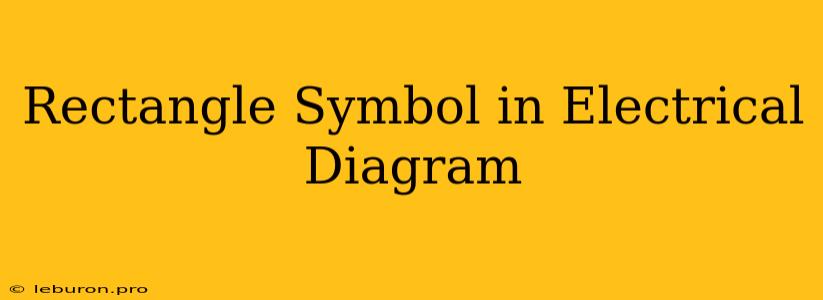The rectangle symbol is a fundamental element in electrical diagrams, representing a wide range of components and functions. Its versatility and simplicity make it a crucial tool for effectively communicating electrical systems. This article delves into the various applications of the rectangle symbol in electrical diagrams, exploring its different meanings and how it aids in understanding complex circuits. We will examine its use in representing different electrical components, control elements, and functional blocks. Furthermore, we will highlight the importance of context and other accompanying symbols in interpreting the rectangle symbol's meaning within a specific diagram.
The Rectangle Symbol: A Versatile Representation
The rectangle symbol in electrical diagrams serves as a versatile tool for representing a variety of components, systems, and functions. Its simplicity allows for a standardized approach to depicting complex electrical systems. This universality makes it a cornerstone of electrical documentation, ensuring clarity and consistency across various applications.
Representing Electrical Components
One of the most common uses of the rectangle symbol is to represent electrical components. It can be used to symbolize a wide range of components, including:
- Resistors: These components resist the flow of current and are typically represented by a simple rectangle with a label indicating their resistance value.
- Capacitors: These components store electrical energy and are usually represented by a rectangle with two lines extending from opposite sides, symbolizing the capacitor's plates.
- Inductors: These components oppose changes in current and are often represented by a rectangle with a coil shape inside, indicating the presence of a winding.
- Transformers: These devices transfer electrical energy from one circuit to another and are frequently represented by a rectangle with two windings, each depicted as a coil.
Representing Control Elements
In addition to representing individual components, the rectangle symbol can also be used to represent control elements, such as:
- Switches: These devices interrupt or complete electrical circuits and are often represented by a rectangle with a contact point and a line indicating the switch's actuation mechanism.
- Relays: These devices control a circuit using an electromagnetic coil and are often represented by a rectangle with a coil symbol and contacts.
- Fuses: These safety devices protect circuits from overcurrent and are typically represented by a rectangle with a wavy line inside, indicating the fuse's melting element.
- Circuit Breakers: These devices interrupt the flow of current in case of a fault and are often represented by a rectangle with a trip handle and a label indicating its trip rating.
Representing Functional Blocks
The rectangle symbol can also be employed to represent functional blocks, such as:
- Power Supplies: These devices convert AC voltage to DC voltage and are often represented by a rectangle with a label indicating its voltage and current output.
- Amplifiers: These devices increase the amplitude of electrical signals and are typically represented by a rectangle with an input and output symbol.
- Filters: These devices select or remove specific frequencies from electrical signals and are usually represented by a rectangle with a filter symbol.
- Sensors: These devices convert physical quantities into electrical signals and are often represented by a rectangle with a symbol indicating the type of sensor.
The Importance of Context and Additional Symbols
It is crucial to understand that the rectangle symbol alone is insufficient for fully comprehending its meaning within an electrical diagram. The context of the diagram, along with other accompanying symbols, plays a vital role in determining the rectangle's specific function.
- Labels and Designations: Labels and designations within the diagram provide essential information about the rectangle's purpose. For example, a label indicating "R1" clarifies that the rectangle represents a resistor with a specific resistance value.
- Connecting Lines and Arrows: Connecting lines and arrows indicate the flow of current and signal connections, providing further context for the rectangle's function.
- Standard Symbols: Utilizing standardized symbols for various components, such as resistors, capacitors, and switches, helps in accurately interpreting the rectangle's meaning.
- Diagram Conventions: Adhering to established diagram conventions ensures consistency and clarity in understanding the rectangle's representation within the larger electrical system.
Conclusion
The rectangle symbol is an indispensable tool in electrical diagrams, offering a concise and standardized way to represent diverse electrical components, control elements, and functional blocks. Its versatility allows for efficient communication of complex electrical systems. However, it's essential to remember that context is paramount in interpreting the rectangle symbol's meaning within a specific diagram. By understanding the associated labels, connections, and diagram conventions, we can accurately decipher the function and role of the rectangle symbol in various electrical applications. The rectangle symbol continues to be a fundamental building block in electrical documentation, ensuring clarity, efficiency, and consistency across a wide range of electrical engineering applications.
